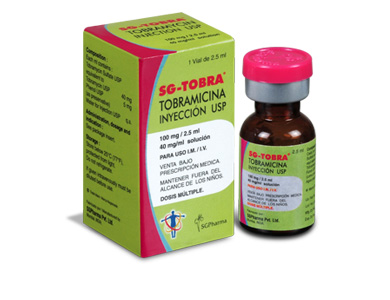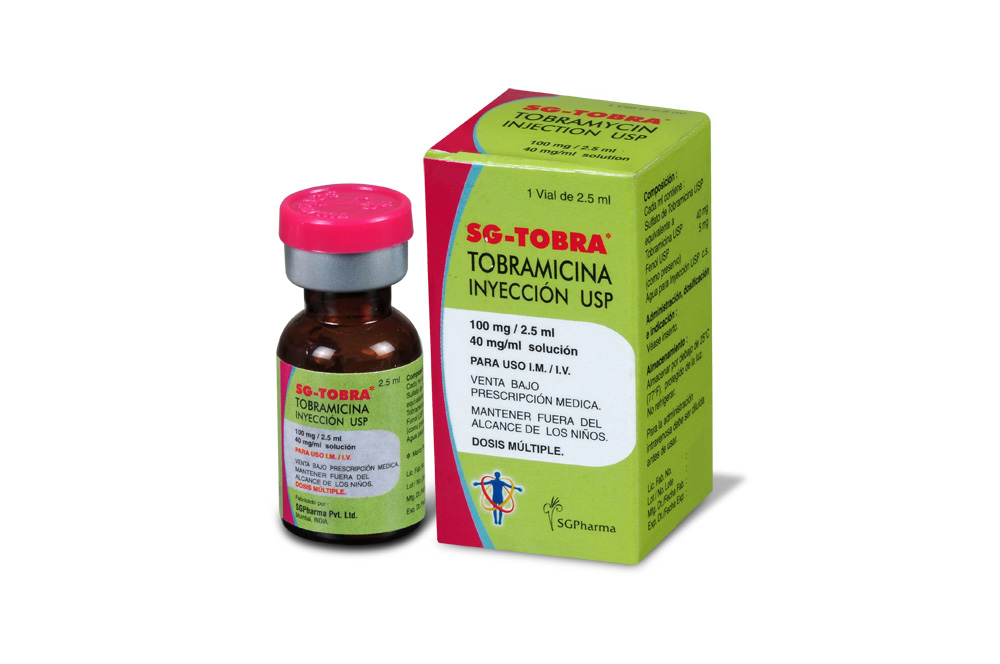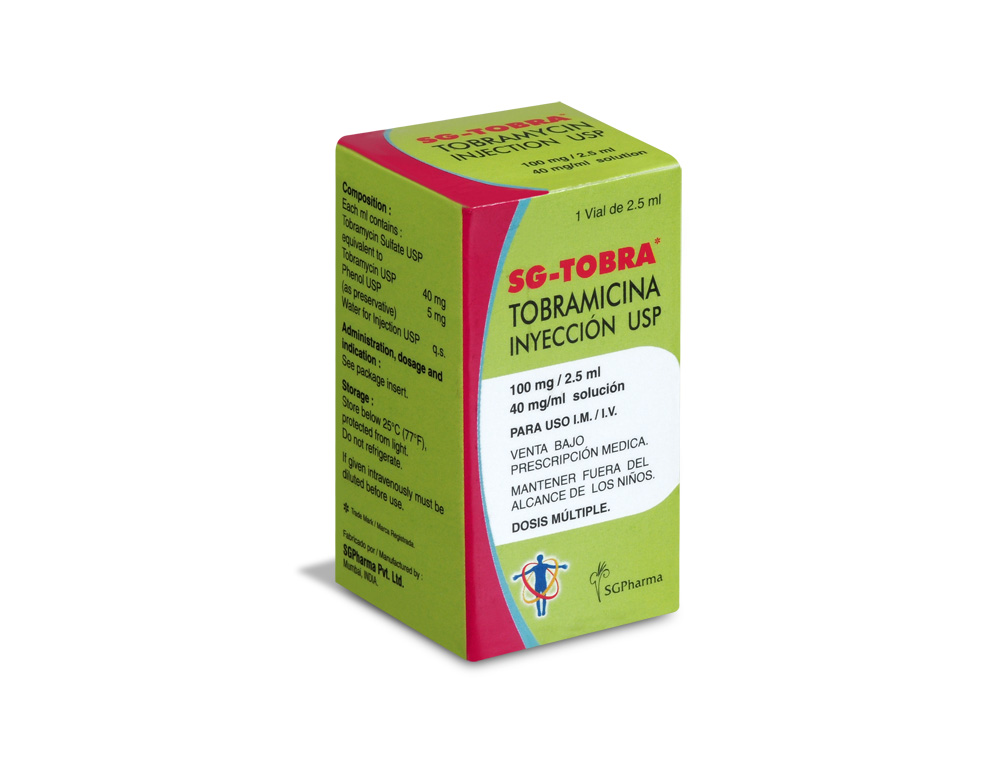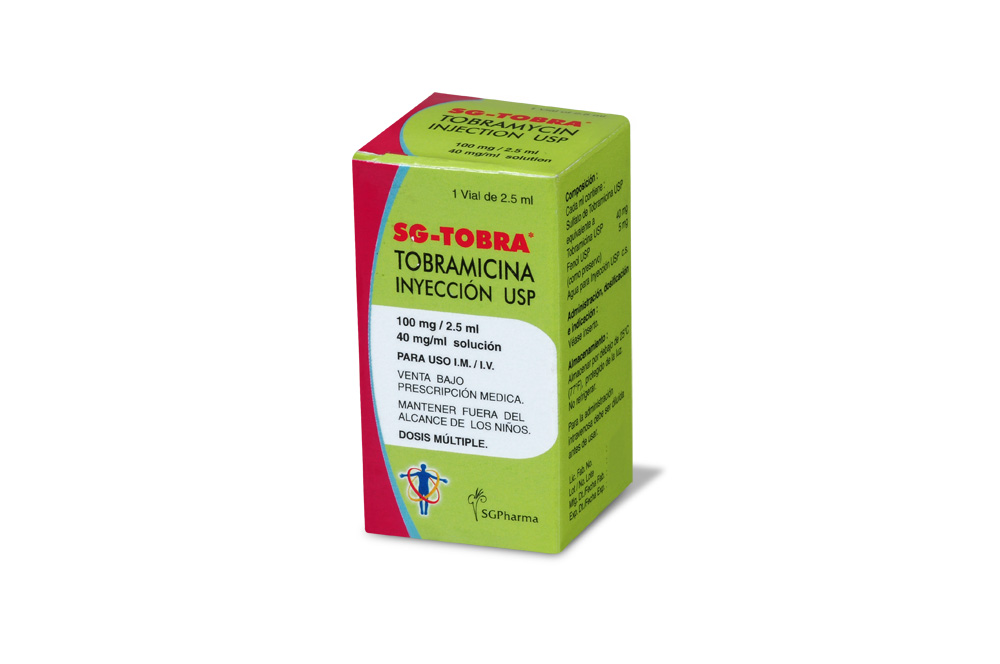
80 mg/2 ml, 100 mg/2.5 ml
For the use of a Registered Medical Practitioner or a Hospital or a Institution only.
Tobramycin Sulfate - (C18H37N5O9)2•5H2SO4 O-3-Amino-3-deoxy-α-D-glucopyranosyl-(1→4)-O-[2,6-diamino-2,3,6-trideoxy-α-D-ribo-hexopyranosyl-(1→6)]-2-deoxy-L-streptamine, Sulfate (2:5) (salt)hexopyranosyl-(1→6)]-2-deoxy-L-streptamine, Sulfate (2:5) (salt).
-Structure.jpg)
SG-TOBRA is sterile, clear, colourless solution filled in vial of suitable size.
PHARMACOLOGY :
Tobramycin is an aminoglycoside antibiotic for parenteral administration. Tobramycin is bactericidal and acts by inhibiting the synthesis of protein in bacterial cells. Tobramycin is usually active against most strains of the following organisms in vitro and in clinical infections : Pseudomonas aeruginosa, Proteus sp (Indole-positive and indole negative), Proteus mirabilis, P rettgeri, and P vulgaris, Escherichia coli, Klebsiella-Enterobacter-Serratia group, Citrobacter sp, Providencia sp, Staphylococci, including Staphylococcus aureus (coagulase-positive and coagulase-negative) Aminoglycosides have a low order of activity against most gram-positive organisms, including, Streptococcus pyrogenes, Streptococcus pneumoniae and enterococci. Although most strains of enterococci demonstrate in vitro resistance, some strains are susceptible. In vitro studies have shown that an aminoglycoside combined with an antibiotic that interferes with cell-wall synthesis affects some enterococcal strains synergistically. The combination of penicillin G and tobramycin results in a synergistic bactericidal effect in vitro against certain strains of Enterococcus faecalis (formerly, Streptococcus faecalis). However, this combination is not synergistic against other closely related organisms, e.g. Enterococcus faecium (formerly, Streptococcus faecium). Speciation of enterococci alone cannot be used to predict susceptibility. Susceptibility testings and tests for antibiotic synergism are emphasized. Cross-resistance between aminoglycosides occurs and depends largely on inactivation by bacterial enzymes.
PHARMACOKINETICS :
Absorption Rapid following intramuscular administration.
Peak serum concentrations Between 30 and 90 minutes after intramuscular administration.
Maximum serum concentrations 4 mcg/ml
Therapeutic serum levels 4 to 6 mcg/ml
Peak serum levels 9.2 to 29.8 mcg/ml following single bolus I.V. injection of 1.5 mg/kg.
Elimination Exclusively by glomerular filtration.
Peak urine concentrations 75 to 100 mcg/ml
Serum half-life 2 hours
INDICATIONS :
Septicaemia in the neonate, child, and adult caused by P. aeruginosa, E. coli and Klebsiella sp. Lower respiratory tract infections caused by P. aeruginosa, Klebsiella sp, Enterobacter sp, Serratia sp, E. coli and S. aureus (penicillinase and non-penicillinase producing strains). Serious central-nervous-system infections (meningitis) caused by susceptible organisms Intra-abdominal infections, including peritonitis, caused by E. coli, Klebsiella sp and Enterobacter sp. Skin, bone and skin-structure infections caused by P. aeruginosa, Proteus sp, E. coli, Klebsiella sp, Enterobacter sp and S. aureus. Complicated and recurrent urinary tract infections caused by P. aeruginosa, Proteus sp (indole-positive and indole-negative), E. coli, Klebsiella sp, Enterobacter sp, Serratia sp, S. aureus, Providencia sp and Citrobacter sp. Tobramycin may be considered in serious staphylococcal infections when penicillin or other potentially less toxic drugs are contraindicated and when bacterial susceptibility testing and clinical judgment indicate its use.
Administration :
SG-TOBRA may be given intramuscularly or intravenously. Recommended dosages are the same for both routes. The patients pretreatment body weight should be obtained for calculation of correct dosage. It is desirable to measure both peak and trough serum concentrations.
Intramuscular administration :
Tobramycin Sulfate may be administered by withdrawing the appropriate dose directly from a vial.
Intravenous administration :
Must dilute for I.V. use. For intravenous administration, the usual volume of diluent (0.9 % Sodium Chloride Injection or 5 % Dextrose Injection) is 50 to 100 ml for adult doses. For children, the volume of diluent should be proportionately less than for adults. The diluted solution usually should be infused over a period of 20 to 60 minutes. Infusion periods of less than 20 minutes are not recommended, because peak serum levels may exceed 12 mcg/ml. Tobramycin sulfate should not be physically premixed with other drugs but should be administered separately according to the recommended dose and route.
CONTRAINDICATIONS :
A hypersensitivity to any aminoglycoside is a contraindication to the use of tobramycin. Intrathecal administration.
WARNINGS :
Neurotoxicity, nephrotoxicity, ototoxicity SG-TOBRA contains sodium metabisulfite, a sulfite that may cause allergic-type reactions including anaphylactic symptoms and life-threatening or less severe asthmatic episodes in certain susceptible people.
Usage in pregnancy :
Aminoglycosides can cause foetal harm when administered to a pregnant woman. Aminoglycoside antibiotics cross the placenta and there have been several reports of total irreversible bilateral congenital deafness in children whose mothers received streptomycin during pregnancy. Serious side effects to mother, foetus, or newborn have not been reported in the treatment of pregnant women with other aminoglycosides.
Nursing mothers :
Aminoglycosides are excreted in breast milk in small but variable amounts, but problems in nursing infants have not been documented because of their poor gastrointestinal absorption.
ADVERSE REACTIONS :
Neurotoxicity :
Symptoms include dizziness, vertigo, tinnitus, roaring in the ears and hearing loss.
Nephrotoxicity :
Anaemia, granulocytopaenia and thrombocytopaenia; and fever, rash, exfoliative dermatitis, itching, urticaria, nausea, vomiting, diarrhoea, headache, lethargy, pain at the injection site, mental confusion and disorientation. Laboratory abnormalities possibly related to tobramycin sulfate include increased serum transaminases (SGOT, SGPT); increased serum LDH and bilirubin; decreased serum calcium, magnesium, sodium and potassium; and leukopenia, leukocytosis and eosinophilia.
DRUG INTERACTIONS :
(i) Antibacterials, antifungals
(ii) Diuretics, general anaesthetics and neuromuscular blocking agents
(iii) Muscle Relaxants, cytotoxics and cyclosporins
(iv) Tobramycin has been known to potentiate warfarin and phenindione
(v) Cholinergics
STORAGE :
Store below 25°C (77°F), protected from light.
Do not refrigerate.
PRESENTATION :
-Table.jpg)
Disclaimer : For the use of a Registered Medical Practitioner or a Hospital or a Institution only. Also it is not intended to be used by healthcare professionals or patients for the purpose of prescribing or administering these products. Questions regarding the complete and current content of product labeling / specification / presentation should be directed to SGPharma.

 Cardiovascular
Cardiovascular








